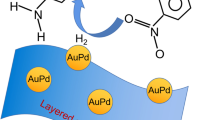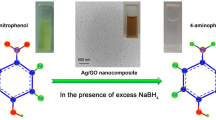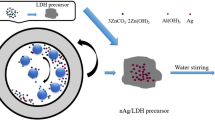Abstract
Catalysts or support to catalysts based on layered double hydroxides (LDHs) have been widely investigated in the last few years. Supported Au nanoparticles (NPs), prepared typically by a homogeneous deposition–precipitation technique, have been utilized as catalysts with high activity and selectivity for styrene epoxidation. We herein present a preparation of chemically reduced and cost-saving Ag NPs on the LDH support used as catalyst for styrene epoxidation. A proper reaction condition is optimized, for example, a loading of 2.67 wt% Ag, a conversion temperature of 82 °C, and a conversion time of 8 h. The Ag/LDH catalyst exhibits enhanced reaction selectivity and product yield in comparison with the Au/LDH reported previously. Our results may initiate a facile framework appropriate for noble metallic NPs supported on layered inorganic crystal compounds.
Similar content being viewed by others
Explore related subjects
Discover the latest articles, news and stories from top researchers in related subjects.Avoid common mistakes on your manuscript.
Introduction
Catalysts or support to catalysts based on layered double hydroxides (LDHs) have been widely investigated in the last few years [1, 2]. LDHs, also known as one type of multifunctional anionic clay [3–9], can be expressed by the general formula [M 2+1−x M 3+ x (OH)2]x+[An−] x/n ·yH2O, where the cations M2+ and M3+ occupy the octahedral holes in a brucite (Mg(OH)2)-like layer, and the anion An− is between the hydrated interlayer galleries. Various studies have demonstrated that the utilization of underlying LDHs as support is able to facilitate the uniform deposition and dispersion of the supported active nanoparticles (NPs) with enhanced catalytic performances [10–14]. Supported metal NP catalysts (such as Pd [10, 13], Au [11, 14], and Ni [12]) have hitherto been prepared either by an impregnating-calcination process, or by direct immobilization, or by intercalation of precursor.
Olefin epoxidation (especially for styrene) is an important reaction to functionalize hydrocarbons due to the capabilities of yielding versatile and valuable intermediates [15]. Typically, supported Au NPs or cluster have been widely utilized as catalysts for the reaction, such as Au/metal oxides [16] and Au25 cluster/hydroxyapatite [17]. Recently, we have shown that the LDH-supported Au catalysts [14], prepared by a homogeneous deposition–precipitation (HDP) technique, exhibited the efficient conversion of styrene with tert-butyl hydroperoxide (TBHP) to styrene oxide (SO). Compared with gold NP catalysis, silver, one less expensive group IB metal, has also been investigated as supported catalysts, such as surfactant-guided Ag/Fe3O4 raspberry-like nanosphere [18]. In the context of low operating conditions and cost-saving preparation routes, it is still of genuine interest to prepare efficient supported catalysts using a facile approach.
In this present study, we have prepared Ag NPs on the LDH support with uniform particle distribution via facile chemical reduction. Catalytic performances were tuned on conversion of styrene using TBHP as oxidant under air atmosphere initially by varying Ag loadings, then conversion temperature, and further conversion time. And also, the catalytic reusability was examined.
Experimental
Preparation of Ag/MgAl-LDH catalyst
MgAl-LDH support was prepared via a scalable method in our recent studies [14, 19]. Ag/LDH catalysts were prepared by chemical reduction. Briefly, a mixture of 5 mL solution of AgNO3 (0.017, 0.051, 0.086, and 0.117 mol/L) and 20 mL suspension of LDH (1.0 g) was vigorous stirred at 0 °C for 30 min [20], filtered, and washed with deionized water. The following reduction was performed with an aqueous solution of NaBH4 under an argon atmosphere at 0 °C for 1 h to yield Ag/MgAl-LDH containing 0.93, 2.76, 4.65, and 6.32 wt% Ag. The catalysts were collected, washed, and subsequently dried in vacuum at 60 °C for 24 h.
Catalysts characterization
Powder X-ray diffraction (XRD) patterns were collected on a Shimadzu XRD-6000 instrument. Elemental analyses for Ag were performed by inductively coupled plasma emission spectrometry (ICP-ES, Shimadzu ICP-7500 instrument). Transmission electron microscopic micrograph analyses were performed on JEOL JEM-2100 microscope. The average size of Ag particles was determined by Gaussian fitting the numbers obtained by manually measuring ~200 particles. The specific surface area determination was performed by BET from the N2 adsorption measurements at 77 K using a static volumetric Quantachrome Autosorb-1C-VP Analyzer. Gas chromatography (Shimadzu Technologies, HP-624 capillary column, 30 m × 0.25 mm) was used to monitor catalytic reaction, with flame ionization detector using nitrogen as carrier gas and tetradecane as an internal standard substance. The temperatures of the injector and detector were both 523 K. The products were determined by GC–MS using an HP5790 series mass selective detector.
Styrene epoxidation
A mixture of Ag/LDH catalyst (0.1 g), styrene (10 mmol), acetonitrile (5 mL), and 5 mL aqueous solution of TBHP (analytical grade, 65 wt% in water) was examined under air atmosphere with the different Ag loading, at the reaction temperatures, and then for a certain time. The 2.76 wt% Ag/LDH catalyst was selected for repeating the process for 3 times. The catalyst was recovered by filtration, washed with acetone, and then dried at 60 °C for 24 h under vacuum conditions. Then, the recovered powder (0.1 g) was used to perform a new reaction of epoxidation under the above conditions. Calculations of styrene conversion, selectivity of styrene oxide (SO), benzaldehyde (BA), and phenyl acetaldehyde (PA), yield of SO, as well as turnover of frequency (TOF) were presented below in accordance with our previous study [14]: reactant conversion (%) = (n reactant converted × 100)/n reactant in feed; product selectivity (%) = (n product × 100)/n reactant converted; and SO yield (%) = [Reactant conversion (%) × Product selectivity (%)/100].
Results and discussion
The Ag NP catalyst on the underlying LDH was prepared by using a typical chemical reduction of NaBH4. Figure 1a shows XRD patterns of the resulting Ag/LDH catalysts. The Ag/LDH catalysts and pristine LDH exhibit the characteristic (00 l) at low 2θ angles and (110), (113) at high 2θ angles, clearly indicative of the characteristics of hydrotalcite-like structure. The basal spacing value d 003 of MgAl-LDH is calculated to be 0.74 nm, suggestive of the intercalation of CO3 2− anions between the LDH layer galleries [21]. Also, the intensities of (111), (200), and (220) peaks of Ag increase gradually as the Ag loadings increase from 0.93 to 6.32 %. The increase was confirmed by UV–vis spectra (Fig. 1b), showing that a shift of the peaks can be discerned from 393 nm to 402 nm as Ag loading increases from 0.93, 2.76, 4.65 to 6.32 %. The red shift strongly reveals the abrupt increase in dimensional size for Ag NPs at the high loading of 6.32 % [18], which can be directly visualized by TEM results. TEM images show that the Ag NPs are dispersed on the LDH support (Fig. 2, panels a, c, e, and g). Histograms of size distributions (Fig. 2, panels b, d, f, and h) clearly reveal that the mean sizes of the Ag NPs measured are 6.1 ± 0.8, 6.2 ± 0.7, 6.3 ± 0.6, and 7.9 ± 1.0 nm for the Ag loadings of 0.93, 2.76, 4.65, and 6.32 wt%, respectively. The remarkable increase in dimensional size is in good agreement with the above-mentioned shift of the UV–vis spectra. Closer examination of high-resolution TEM reveals that the measured spacing is 0.23 nm, corresponding to the interplanar (111) spacing of Ag NPs, as observed by the above XRD patterns. In addition, loading efficiency of Ag (the ratio of loaded Ag/starting Ag) was examined by using ICP. The ICP results obtained show that the Ag/LDH catalysts have the loading efficiencies of 93.0, 92.0, 93.0, and 90.3 %, respectively. Also, BET measurement shows that the surface areas were determined to be 13.2, 12.9, 12.7, and 12.2 m2/g for the Ag/LDH catalysts with the increasing Ag loadings, respectively. Perusal of the approximate loading efficiencies and surface areas suggests the reproducibility of utilizing the chemical reduction.
Our previous study has shown that the Au/LDH catalyst with Au a loading of 5.48 wt% exhibited enhanced styrene conversion, SO selectivity, and yield of SO [14], in comparison with the Au NPs on metal oxides (such as MgO [16] and Al2O3 [22]). In this case, catalytic performance of Ag/LDH catalyst was thus mediated initially by varying Ag loadings. Table 1 indicates that the conversions of styrene and SO yield increase dramatically with the increasing Ag loadings from 0.93 to 2.76 wt%, and then slightly increase up to the loading of 6.32 % Ag. The selectivity of SO was observed to be preserved above 90 %, in marked contrast to the low selectivity of the byproducts of BA and PA. Considering the decreasing values of TOF (68.6, 36.4, 21.6, 17.4 h−1) with increasing Ag loading, the loading of Ag NPs was determined to be 2.76 %.
Conversion temperature was then tuned based on the Ag/LDH catalyst with the fixed Ag loading of 2.76 wt%. Table 2 shows that the conversion of styrene and selectivity of SO significantly increase from room temperature (22 °C), through 42, 62 to 82 °C. At 82 °C, the maximum styrene conversion and SO yield were observed to be 80.8 and 73.6 %, respectively. Based on the maximum value (36.4 h−1) of TOF achieved, an optimal temperature was determined to be 82 °C.
Conversion time was further modulated at 82 °C on the basis of the 2.76 wt% Ag/LDH catalyst. Table 3 shows that with extending conversion times to 8 h, the conversion of styrene and the SO yield increases dramatically and then remains almost constant when approaching 12 h. The maximum selectivity of SO was found to be at the reaction time of 8 h. In the context of convenient, time- and cost-saving formulization, the reaction conditions were thus optimized to be a loading of 2.67 %, a conversion time of 8 h at 82 °C. At the optimized conditions, the styrene conversion, SO selectivity, and yield of SO were achieved to be 80.8, 91.1, and 73.6 %, respectively.
Reusage was examined for the above-optimized 2.67 %Ag/LDH catalyst. Upon repeating the process 3 times, no remarkable decrease was observed for styrene conversion or yield of SO, and the values of selectivity of SO and TOF were almost constant (Fig. 3). Also, ICP results show that no Ag was detected in each filtrate after repeating 3 consecutive runs with the same catalyst sample. This suggests an acceptable reusability in both catalytic activity and selectivity for the epoxidation. Additionally, this reusability of the Ag NPs/LDH catalyst manifests that the chemical reduction via NaBH4 is indeed one effective and reproducible method to prepare noble metallic NPs on the underlying supports, as reported previously for the catalysts such as Au/LDH [23], Pd/LDH [13], Ag/hydroxyapatite [24], and Au–Pt nanoalloy particles/polymer bead [25].
Comparison with the supported Au NPs shows that in this case, the optimized Ag/LDH catalyst exhibited highly enhanced SO selectivity and yield of SO compared with the Au/LDH catalyst at the similar reaction conditions [14]. Also, previous studies of epoxidation of styrene have demonstrated that both the supported Au25 cluster [17] and the raspberry-like Ag/Fe3O4 [18] showed the excellent styrene conversions of 100 %. When considering the fact that the surface areas of the Ag/LDH catalysts were determined by surface area measurement (BET) to be 13.2, 12.9, 12.7, and 12.2 m2/g for the Ag loadings of 0.93, 2.76, 4.65, and 6.32 %, respectively, we found out that all the Ag/LDH catalysts exhibited the approximate but low surface areas. The enhancements of the previous studies could initiate us to improve the Ag/LDH catalysts in terms of hierarchical nanospheres and high surface area.
In addition to styrene epoxidation [18], supported Ag NPs are able to act as effective catalysts for other types of reactions in the form of either mono- or bi-metallic NPs [26–31]. The metallic NP catalysts used and the corresponding reactions include Ag/MgAl-LDH catalyst for oxidant-free alcohol dehydrogenation [26], Ag/silica for alkylation of arenes [27], Ag/hydroxyapatite for aqueous oxidation of phenylsilanes to silanols [24], Ag/Al2O3 for ethylene epoxidation [28] and hydrogen auto-transfer C–C coupling reaction of alcohols [29], and Au–Ag bimetallic NPs/silica for CO oxidation [30], as well as Pd–Ag bimetallic NPs/Al2O3 for ethylene epoxidation [31]. Comparing with the above-mentioned supports (such as hydroxyapatite, silica, and Al2O3), the LDH support has been demonstrated to act as quite effective supports for metallic NP catalyst, due to the collaborative contributions to the catalytic reactions resulting from both acid–base hydroxyl group pairs on the LDH layer surface [32] and the uniform deposition and dispersion of the supported NPs [10–14]. In this case, the Ag/LDH catalysts could be expected to extend readily to the above reactions such as oxidant-free alcohol dehydrogenation and ethylene epoxidation.
Conclusion
We have explored a formulation of cost-saving Ag/LDH catalyst used for epoxidation of styrene. It is possible to formulate catalytic reaction conditions by initially varying loading of Ag NPs, then reaction temperature, and time. The optimized Ag/LDH is able to exhibit an enhanced conversion of styrene and SO selectivity in comparison with the supported Au NPs catalysts reported previously under the similar reaction conditions. Our results may allow for preparation of promising and cost-saving supported metallic NP catalysts with enhanced catalytic performances.
References
Wang Q, O’Hare D (2012) Chem Rev 112:4124
Roeffaers MBJ, Sels BF, Uji-i H, de Schryver FC, Jacobs PA, Vos DED, Hofkens J (2006) Nature 439:572
Coronado E, Martí-Gastaldo C, Navarro-Moratalla E, Ribera A, Blundell SJ, Baker PJ (2010) Nat Chem 2:1031
Hussein M, Hwa T (2000) J Nanoparticle Res 2:293
Yang Z, Song Z, Chu G, Kang X, Ren T, Yang W, Qiao Q (2012) J Mater Sci 47:4205
Zhang X, Zhang P, Wu Z, Zhang Z (2012) J Mater Sci 47:2757
Xiao R, Wang W, Pan L, Zhu R, Yu Y, Li H, Liu H, Wang S-L (2011) J Mater Sci 46:2635
Lv F, Wu Y, Zhang Y, Shang J, Chu P (2012) J Mater Sci 47:2033
Shimamura A, Jones M, Kanezaki E, Metson J (2012) J Mater Sci 47:1142
Feng JT, Ma X, He YF, Evans DG, Li DQ (2012) Appl Catal A 413–414:10
Liu Q, Fan G, Zhang S, Liu Y, Li F (2012) Mater Lett 82:4
Morandi S, Manzoli M, Prinetto F, Ghiotti G, Gérardin C, Kostadinova D, Tichit D (2012) Micropor Mesopor Mater 147:178
Singha S, Sahoo M, Parida KM (2011) Dalton Trans 40:7130
Zhang FZ, Zhao X, Feng C, Li B, Chen T, Lu W, Lei X, Xu SL (2012) ACS Catal 1:232
Adam W, Saha-Moller CR, Ganeshpure PA (2001) Chem Rev 101:3499
Patil NS, Uphade BS, McCulloh DG, Bhargava SK, Choudhary VR (2004) Catal Commun 5:681
Liu Y, Tsunoyama H, Akita T, Tsukuda T (2010) Chem Commun 46:550
Zhang D-H, Li G-D, Lia J-X, Chen J-S (2008) Chem Commun 44:3414
Li M, Yin Y-X, Li C, Zhang F, Wan L-J, Xu SL, Evans DG (2012) Chem Commun 48:410
Jin L, He D, Li Z, Wei M (2012) Mater Lett 77:67
Haruta M, Kobayashi T, Sano H, Yamada N (1987) Chem Lett 16:405
Patil NS, Jha R, UB S, Bhargava SK, Choudhary VR (2004) Appl Catal A 275:87
Liu P, Guan Y, Santen RAV, Li C, Hensen EJM (2011) Chem Commun 47:11540
Mitsudome T, Arita S, Mori H, Mizugaki T, Jitsukawa K, Kaneda K (2008) Angew Chem Int Ed 47:7938
Schrinner M, Ballauff M, Talmon Y, Kauffmann Y, Thun J, Möller M, Breu J (2009) Science 323:617
Mitsudome T, Mikami Y, Funai H, Mizugaki T, Jitsukawa K, Kaneda K (2008) Angew Chem Int Ed 47:138
Shimizu K, Miyamoto Y, Satsuma A (2010) ChemCatChem 2:84
Christopher P, Linic S (2008) J Am Chem Soc 130:11264
Shimizu K, Sato R, Satsuma A (2009) Angew Chem Int Ed 48:3982
Yen C-W, Lin M-L, Wang A, Chen S-A, Chen J-M, Mou C-Y (2009) J Phys Chem C 113:17831
Dellamorte JC, Lauterbach J, Barteau MA (2011) Appl Catal A 391:281
Lei X, Zhang F, Yang L, Guo X, Tian Y, Fu S, Li F, Evans DG, Duan X (2007) AIChE J 53:932
Acknowledgements
We greatly thank Prof. Xiaoming Sun for helpful suggestions. This work was financially supported by National Natural Science Foundation of China, 973 Program (No. 2011CBA00506), and the Fundamental Research Funds for the Central Universities (No. ZZ1128).
Author information
Authors and Affiliations
Corresponding authors
Additional information
Xiaotong Wang and Zhongqiang Liang have contributed equally to this work.
Rights and permissions
About this article
Cite this article
Wang, X., Liang, Z., Zhang, F. et al. Enhanced catalytic performances of Ag nanoparticles supported on layered double hydroxide for styrene epoxidation. J Mater Sci 48, 5899–5903 (2013). https://doi.org/10.1007/s10853-013-7385-7
Received:
Accepted:
Published:
Issue Date:
DOI: https://doi.org/10.1007/s10853-013-7385-7







